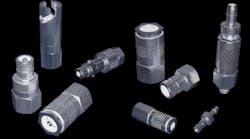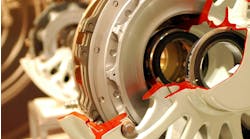Quick disconnect fittings (QDs), also known as quick connects or quick-release couplings, reduce downtime during accessory or equipment changeovers, simplify and speed up servicing, reduce leaks and simplify diagnostics. They do not require tools for assembly or disassembly like hydraulic line connectors. And they come in many different types and are used throughout a broad range of industries.
QD Factors
Whether selecting a QD for retrofitting equipment or during the design process, there are many factors to consider. These fittings typically have several components in the fluid path, so they often have greater pressure drops than simpler fittings. Therefore, it is important to know (and confirm) that a fitting will deliver the required flow performance required for the application. Likewise, because QDs can have pressure limitations, ensure the specified fitting can handle the application’s maximum service pressure.
Material selection also is important. The fitting’s material needs to be compatible with the working fluid and handle the application’s maximum and minimum temperatures. Fortunately, QDs come in a variety of materials, including metallic components of brass, electroless nickel-plated brass, 303 and 316 stainless steels, in addition to elastomeric components such as Buna-N, EDPM, Viton, silicone and perfluoroelastomers. Plastic quick disconnects also are available from some manufacturers. In any case, manufacturer should be consulted for specific details.
- Does the connector need a shut-off mechanism on either or both ends?
- Is a no shut-off mechanism preferred to maximize flow capacity?
- Is a “dry breaking” disconnection (often termed “no spill” disconnection) required?
- Is a non-latching disconnect required?
- Do several fluid lines need to be connected or disconnected simultaneously?
- What types of tubing or hose will be use with the fittings?
Types of QD Fittings
The most commonly used types of QD fittings include snap-type (ball-latching), bayonet, threaded, and non-latching. In addition, many of these styles are available in single- and double-shutoff, non-shutoff and dry break configurations. Here are some details on each type:
Snap-type (also known as ball-latching) quick connects are the most widely used style. They incorporate a spring-loaded ball-latching mechanism that locks the two halves automatically when they are pushed together. When the releasing sleeve is pulled back, the internal and external ends quickly disengage. This quick-release feature is simple to operate and an advantage in applications requiring frequent connects and disconnects. These QDs can also be disconnected one-handed. Typically, they handle pressures in the range of hundreds of psig.
Non-latching QDs are used when quick serviceability in a compact envelope is needed. This includes cases where a portion of the equipment requires frequent changeout, when the releasing sleeve may be inaccessible, and when users incorporate the QD directly into a custom mounting plate. Non-latching QDs often have self-sealing valves in both halves, so they will automatically contain the fluid in the lines upon disconnection. However, no-shut-off and single-shut-off variants are also available. Many manufacturers make various types non-latching QDs.
Single shut-off QDs have a valve in the internal half of the assembly to prevents fluid from escaping. This is an advantage when filling or releasing pressure from a chamber or portable device and then disconnecting the fill line. Because of possible injury from energized fluid or exposure to the fluid, users are cautioned to wear eye protection during these procedures with single shut-off connectors.
Double Shut-off QDs have shut-off valves in their internal and their external ends, so they retain pressure in both fluid lines when an assembly is connected or disconnected. They are ideal for minimizing leaks when handling expensive or hazardous fluids. Although they have shut-off valves on both ends, some fluid can still leak out if the lines are under pressure when connecting or disconnecting, particularly from the external end.
Dry break QDs are used when the level of sealing needed goes beyond what double shut-off QDs can provide. They ensure shut-off valves in the connector’s internal and external ends are fully closed before disconnection. Also, both halves of the disconnect make a seal before the shut-off valves are opened during disconnection. Sometimes known as “no-spill” disconnects, they typically have a little dead volume to prevent trapped fluid from escaping or dripping when disconnected, for applications where reducing leaks is paramount.
Other Considerations
The QD’s effective orifice rating is a major factor in applications with high flow requirements. Manufacturers offer QDs with a range of orifice sizes to meet effective orifice rating requirements. Predictably, the fitting’s gets larger as the effective orifice rating increases.
Pressure rating should also be considered to ensure the QD has an adequate pressure rating for the application. Some types, such as snap-types, are rated up to maximum pressures in the hundreds of psig, while bayonet-style QDs handle pressures in the thousands of psig. The bayonet-style units can be disconnected one-handed by giving the connection a quarter turn. However, they can be more difficult to connect at these higher pressures, as users must overcome the forces acting on the shutoff mechanism and the forces generated by the shutoff springs.
Editor's Note: All photos and supporting reference material supplied by Beswick Engineering.




